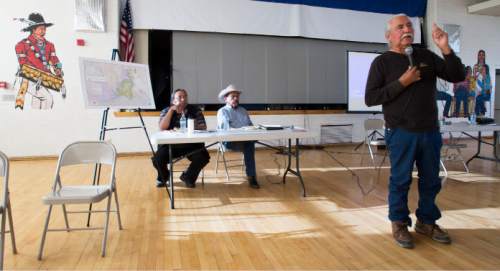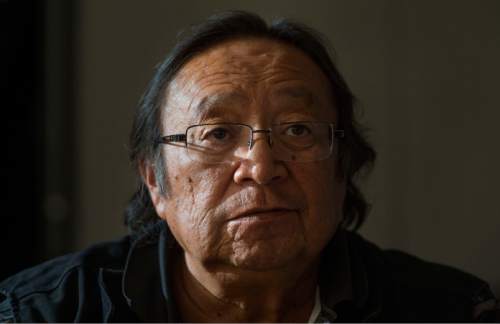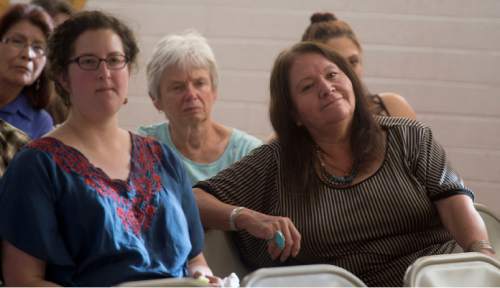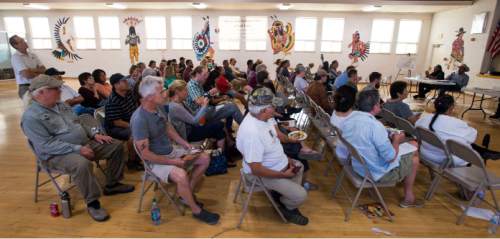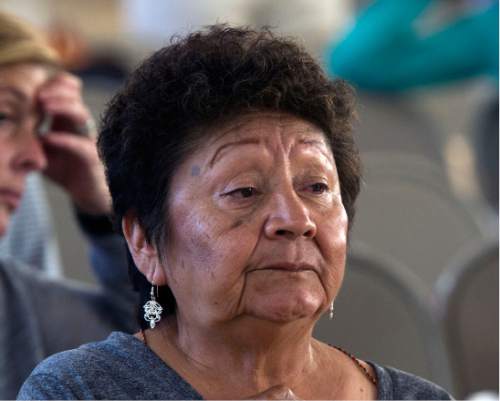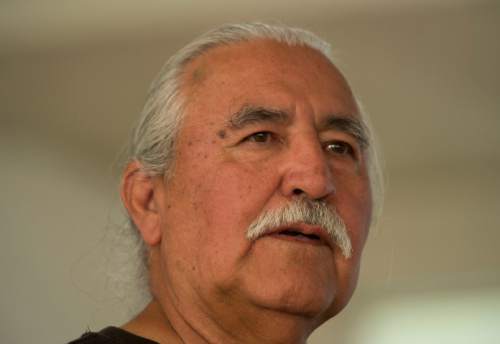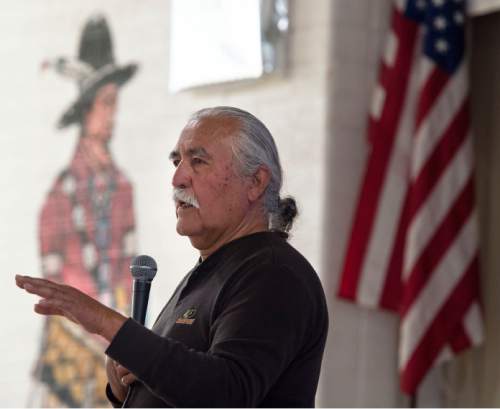This is an archived article that was published on sltrib.com in 2016, and information in the article may be outdated. It is provided only for personal research purposes and may not be reprinted.
Tragedy and betrayal populate the history of the Navajo people, who were forced from their homeland in the 1860s by a federal government that treated them as a conquered people rather than native citizens.
A century of abuses followed the tribe's return to a reservation straddling the Four Corners, but for generations a beacon of hope jutted up on the northern horizon, according to Willie Grayeyes, a Navajo who leads the grass-roots nonprofit Utah Dine Bikeyah.
In English, the twin land forms became known as Bears Ears Buttes, because of their resemblance to the furry nubs rising off an ursine head.
"My elders and medicine people point to the north at social gathering, ceremonies, chapter meetings, reference Bears Ears and say, 'That's where my great-great-grandmother and grandfather used to live, or hunt or sweat.' That psychological attachment is still there. It never has been damaged by weather, rain or wind. And that's what I understood the attachment is, like mother to child, more closer than anybody else," Grayeyes told a gathering of about 70 people Wednesday at the Urban Indian Center in Salt Lake City.
The people came to hear about his group's proposal, endorsed by a multitude of tribes, for a 1.9-million-acre national monument protecting these twin buttes and surrounding public lands, including Cedar Mesa, Grand Gulch, White Canyon, Comb Ridge and the Abajo Mountains — a scenic landscape rich in archaeology and held sacred. Four other Utah Dine Bikeyah (UDB) board members addressed the meeting, part of a tour around Utah and neighboring states to discuss with Native Americans their monument proposal, which has become deeply controversial.
For the first time ever, American Indian tribes are petitioning the federal government — the one that sold them out in the 19th century — to designate a national monument. And it appears the Obama Administration, which has the authority to oblige the request under the 1906 Antiquities Act, is listening. During a major conservation speech recently, Interior Secretary Sally Jewell announced a visit to Utah this summer, leaving many to wonder if her purpose is to announce a new monument for the Bears Ears region.
This possibility has Utah's elected leaders, who have no interest in seeing another big monument "unilaterally" imposed on Utah by a Democratic president, scrambling to drum up opposition. Utah's Gov. Gary Herbert and Sen. Orrin Hatch denounced the proposal Thursday at Natural Bridges National Monument, located on the edge of Cedar Mesa.
The governor's office invited Navajos opposed to a monument, such San Juan County Commissioner Rebecca Benally, but didn't bother to inform the UDB Herbert was visiting the landscape the group is trying to protect, according to executive director Gavin Noyes. The organization only learned of Herbert's appearance from a reporter's inquiry. Board member Albert Holiday, who holds an elected position as Oljato Chapter vice president, quickly returned home from Salt Lake City to attend the politicians' appearance at Natural Bridges.
The UDB proposal calls for strong tribal influence in management decisions and continued access for traditional and ceremonial uses. Bears Ears is the last place where firewood and herbs remain available for Navajos to gather, according to UDB board member Jonah Yellowman. While monument foes say a monument would put an end to such traditional activities, proponents say they have written them into the proposal.
"How do you live? You like the same things I do," said Yellowman, who serves as the group's spiritual adviser. "You like beautiful lands. You like to go hunting. You like to protect places. That's what we want. I want you to work with our families. Petroglyphs are being destroyed. Do something about it. Protect it so it will be there for a long time."
Benally has alleged few if any Utah Navajo endorse the monument proposal and the tribal groups pushing it are bought off by environmental groups. Despite a lack of evidence to back this claim, prominent Utah politicians denounce tribes' support for a monument as a "charade," and have called on Utah Attorney General Sean Reyes to investigate pro-monument groups. (His office won't say whether such an investigation is underway.)
"I don't like what they say. I don't know what they are thinking," said Holiday, whose name was signed to a phony letter circulating in San Juan County. The letter claims pro-monument tribal leaders have been paid by environmentalists in exchange for their support and the lands would no longer be sacred or accessible if a monument is designated.
The letter is a fake, but that has not stopped Rep. Rob Bishop, state Rep. Mike Noel, R-Kanab, and other political figures from parroting its claims that "outside" groups are behind the proposal.
In a recent Tribune interview, Bishop claimed you have to drive five hours to find a Native American who supports a monument.
UDB has found at least 1,101 far inside a five-hour radius. That's how many Native Americans living near Bears Ears who have sent pro-monument letters to the president.
"This is where we collect herb medicine, pick pinyon and offer our prayers. We like it the way it is. The [San Juan County] commissioners are for the oil, coal, uranium. They want to drill the land and disturb it," Holiday said.
Grayeyes claimed the monument idea enjoys broad support among Utah Navajo. He joked that the opponents could all fit into a hogan, a traditional Navajo dwelling.
Work on the monument proposal began in 2010 and came together after in-depth consultation with American Indians, according to Grayeyes.
The elected bodies of various tribes with ancestral ties to Cedar Mesa signed on and UDB offered the proposal under the Utah Public Lands Initiative, Bishop's multi-year effort to resolve eastern Utah's land-use battles. Grayeyes said his group tried its best to work within the process, which has yet to produce a bill even as Obama's tenure draws to a close. However UDB was shut out, prompting it to seek a solution that doesn't need approval from Congress or Utah leaders.
"I don't know if they ever read it, but they dismissed the whole proposal. We tried to work with them. We had an interlocal agreement. It didn't work," Grayeyes said.
Brian Maffly covers public lands for The Salt Lake Tribune. Maffly can be reached at bmaffly@sltrib.com or 801-257-8713.
Twitter: @brianmaffly



